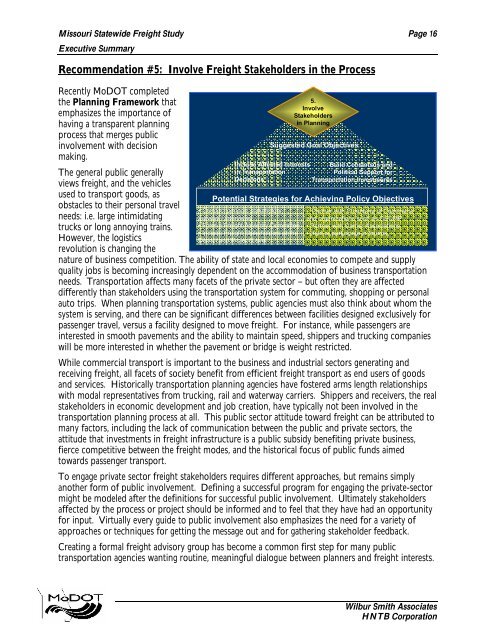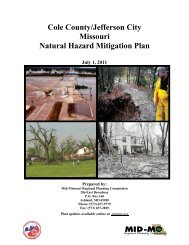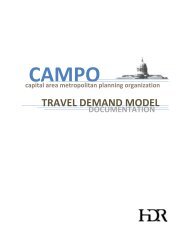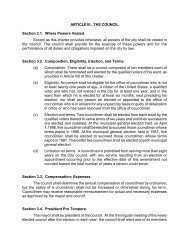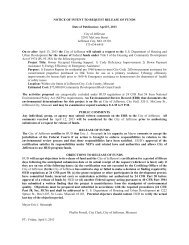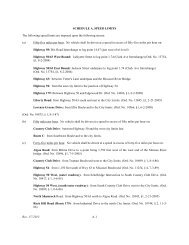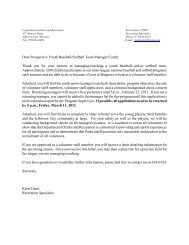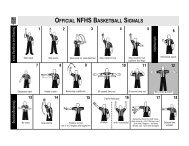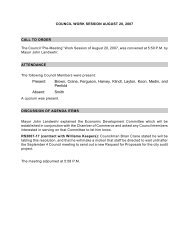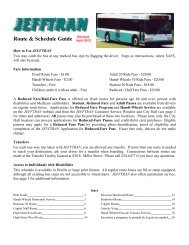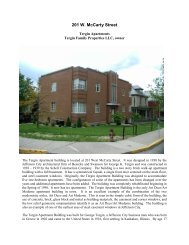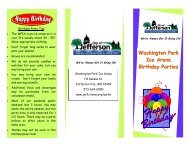MO Freight Executive Summary
MO Freight Executive Summary
MO Freight Executive Summary
You also want an ePaper? Increase the reach of your titles
YUMPU automatically turns print PDFs into web optimized ePapers that Google loves.
Missouri Statewide <strong>Freight</strong> Study Page 16<br />
<strong>Executive</strong> <strong>Summary</strong><br />
Recommendation #5: Involve <strong>Freight</strong> Stakeholders in the Process<br />
Recently MoDOT completed<br />
the Planning Framework that<br />
emphasizes the importance of<br />
having a transparent planning<br />
process that merges public<br />
involvement with decision<br />
making.<br />
The general public generally<br />
views freight, and the vehicles<br />
used to transport goods, as<br />
obstacles to their personal travel<br />
needs: i.e. large intimidating<br />
trucks or long annoying trains.<br />
However, the logistics<br />
revolution is changing the<br />
Suggested Goal Objectives<br />
Include Affected Interests<br />
in Transportation<br />
Build Consensus and<br />
Political Support for<br />
Decisions<br />
Transportation Investments<br />
Potential Strategies for Achieving Policy Objectives<br />
•Conduct periodic stakeholder<br />
surveys / interviews<br />
•Form a <strong>Freight</strong> Advisory Committee<br />
•Include <strong>Freight</strong> Stakeholders at the<br />
District and Project Level<br />
5.<br />
Involve<br />
Stakeholders<br />
in Planning<br />
• Partner with Chambers of Commerce<br />
and organizations such as CSCMP<br />
•Partner with Carrier Associations<br />
•Hold or participate in forums<br />
nature of business competition. The ability of state and local economies to compete and supply<br />
quality jobs is becoming increasingly dependent on the accommodation of business transportation<br />
needs. Transportation affects many facets of the private sector – but often they are affected<br />
differently than stakeholders using the transportation system for commuting, shopping or personal<br />
auto trips. When planning transportation systems, public agencies must also think about whom the<br />
system is serving, and there can be significant differences between facilities designed exclusively for<br />
passenger travel, versus a facility designed to move freight. For instance, while passengers are<br />
interested in smooth pavements and the ability to maintain speed, shippers and trucking companies<br />
will be more interested in whether the pavement or bridge is weight restricted.<br />
While commercial transport is important to the business and industrial sectors generating and<br />
receiving freight, all facets of society benefit from efficient freight transport as end users of goods<br />
and services. Historically transportation planning agencies have fostered arms length relationships<br />
with modal representatives from trucking, rail and waterway carriers. Shippers and receivers, the real<br />
stakeholders in economic development and job creation, have typically not been involved in the<br />
transportation planning process at all. This public sector attitude toward freight can be attributed to<br />
many factors, including the lack of communication between the public and private sectors, the<br />
attitude that investments in freight infrastructure is a public subsidy benefiting private business,<br />
fierce competitive between the freight modes, and the historical focus of public funds aimed<br />
towards passenger transport.<br />
To engage private sector freight stakeholders requires different approaches, but remains simply<br />
another form of public involvement. Defining a successful program for engaging the private-sector<br />
might be modeled after the definitions for successful public involvement. Ultimately stakeholders<br />
affected by the process or project should be informed and to feel that they have had an opportunity<br />
for input. Virtually every guide to public involvement also emphasizes the need for a variety of<br />
approaches or techniques for getting the message out and for gathering stakeholder feedback.<br />
Creating a formal freight advisory group has become a common first step for many public<br />
transportation agencies wanting routine, meaningful dialogue between planners and freight interests.<br />
Wilbur Smith Associates<br />
HNTB Corporation


